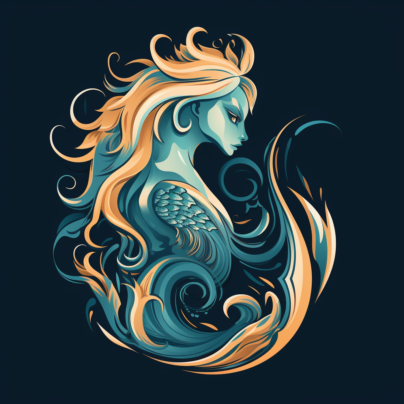“Selkie: The Enchanting Shape-Shifter of Sea and Shore”
A Selkie is a hauntingly beautiful shapeshifter who slips between seal and human form, luring mortals with sea-drenched allure while guarding the stolen skin that binds their freedom.

In their natural state, selkies resemble sleek, dark-eyed seals with an uncanny intelligence shining in their gaze. When they shed their supple, water-slick skins, they transform into humans of striking beauty, often marked by an otherworldly sheen to their hair and a lingering scent of brine. Their eyes retain a deep, oceanic melancholy, betraying their dual nature.
Behaviour
Selkies are secretive and cautious, preferring to avoid direct confrontation unless threatened. They are drawn to shorelines during moonlit nights, where they dance, sing, and commune with others of their kind. While gentle and curious, they are wary of mortals, for legends abound of humans who steal their seal-skins to bind them into servitude.
Habitat
Selkies dwell along cold, rocky coasts, kelp forests, and remote isles, thriving where sea meets land. They are most often encountered in northern waters and rarely stray far inland, for their survival depends upon access to the ocean. Hidden sea caves and wave-worn grottos often serve as their lairs.
Modus Operandi
Though not natural predators of humanoids, selkies are formidable when cornered, using swift dives, slippery agility, and powerful swimming to evade attackers. In human form, they may rely on song and charm to disarm conflict or lure foes into treacherous waters. Their greatest vulnerability lies in their seal-skin—without it, a selkie cannot return to the sea and may be compelled to obey whoever holds it.
Motivation
Above all, selkies are driven by the call of the ocean and the freedom of the waves. They yearn for companionship but fear captivity, leading many to live lives of bittersweet longing between land and sea. Some seek love among mortals, others revenge against those who wronged their kind, but all are bound by an unshakable instinct to reclaim their seal-skin and return to the deep.
Selkie 5e 2024
Selkie. Pathfinder
Selkie

Medium fey (shapechanger), neutral
Armor Class 13 (natural armor)
Hit Points 75 (10d8 + 30)
Speed 30 ft., swim 40 ft.
| STR | DEX | CON | INT | WIS | CHA |
|---|---|---|---|---|---|
| 12 (+1) | 16 (+3) | 16 (+3) | 11 (+0) | 14 (+2) | 17 (+3) |
Saving Throws Dex +5, Cha +5
Skills Deception +5, Perception +4, Persuasion +5, Stealth +5
Damage Resistances cold; bludgeoning, piercing, and slashing from nonmagical attacks while within 30 ft. of seal-skin
Condition Immunities charmed (while within 30 ft. of seal-skin), frightened
Senses darkvision 60 ft., passive Perception 14
Languages Sylvan, Aquan, Common
Challenge 3 (700 XP)
Proficiency Bonus +2
Traits
Amphibious. The selkie can breathe air and water.
Seal-Skin Bond. The selkie’s magical seal-skin grants it resistance to bludgeoning, piercing, and slashing damage while within 30 feet. The selkie cannot be magically charmed while its skin is present. If the seal-skin is stolen or destroyed, the selkie loses these benefits and is trapped in humanoid form.
Shapechanger. The selkie can use its action to transform between humanoid and seal form. While in seal form, it gains a swim speed of 60 ft., advantage on Stealth checks made in water, and cannot wield weapons.
Innate Spellcasting. The selkie’s innate spellcasting ability is Charisma (spell save DC 13, +5 to hit with spell attacks). It can cast the following spells innately, requiring no material components:
- At will: minor illusion, shape water
- 3/day each: charm person, fog cloud
- 1/day each: hold person, calm emotions
Actions
Multiattack. The selkie makes two attacks with its Wave-Touched Strikes.
Wave-Touched Strike (Humanoid or Seal Form). Melee Weapon Attack: +5 to hit, reach 5 ft., one target. Hit: 7 (1d8 + 3) bludgeoning damage plus 4 (1d8) cold damage.
Siren’s Call (Recharge 5–6). The selkie sings a haunting melody. Each creature of the selkie’s choice within 30 feet that can hear it must succeed on a DC 13 Wisdom saving throw or be charmed for 1 minute. A charmed creature is incapacitated while listening and moves up to 10 feet toward the selkie at the start of its turn. The effect ends if the selkie or its allies attack the creature.
Reactions
Slip Beneath the Waves. When hit by a melee attack, the selkie can move up to half its swim speed into water without provoking opportunity attacks.
Legendary Actions
The selkie can take 2 legendary actions, choosing from the options below. Only one legendary action can be used at a time and only at the end of another creature’s turn.
- Water Veil. The selkie surrounds itself with mist, gaining advantage on its next Dexterity saving throw.
- Tail Sweep (Seal Form Only, 1 action). The selkie sweeps with its tail; one creature within 5 ft. must succeed on a DC 13 Strength saving throw or be knocked prone.
- Lure the Heart (2 actions). One creature charmed by the selkie immediately moves up to 15 ft. toward it.
Tactics
Selkies avoid direct confrontation, using charm, illusion, and mobility to control the battlefield. They open combat with fog cloud or calm emotions, then attempt to incapacitate foes with Siren’s Call. In seal form, they rely on their superior swimming speed and Slip Beneath the Waves to retreat and strike unexpectedly. They focus on reclaiming their seal-skin if it is taken, prioritizing survival and freedom over conquest.
Selkie

This beautiful woman changes shape rapidly to become a sleek, aquatic creature with a gray hide of short fur. Her webbed hands end in sharp claws, and her jaws open unnaturally wide to reveal pointed teeth.
Selkie CR 5
XP 1,600
CN Medium monstrous humanoid (aquatic, shapechanger)
Init +7; Senses darkvision 60 ft., scent; Perception +9
DEFENSE
AC 18, touch 13, flat-footed 15 (+3 Dex, +5 natural)
hp 45 (6d10+12)
Fort +4, Ref +8, Will +5; Resist cold 10
OFFENSE
Speed 20 ft., swim 50 ft.
Melee bite +10 (1d8+6), 2 claws +10 (1d6+4)
Special Attacks powerful blows (bite), shake
STATISTICS
Str 18, Dex 17, Con 14, Int 13, Wis 10, Cha 19
Base Atk +6; CMB +10; CMD 23 (can’t be tripped)
Feats Combat Reflexes, Deceitful, Improved Critical B (bite), Improved Initiative
Skills Bluff +12, Disguise +10, Perception +9, Sense Motive +4, Stealth +10, Swim +21
Languages Aquan, Common
SQ change shape (any Small or Medium humanoid; alter self), echo of reason, hold breath
SPECIAL ABILITIES
Echo of Reason (Su)
A selkie can instinctively alter the intonation of its voice to make anything it says sound more pleasing to those who understand it. When using the Bluff skill, a selkie treats its lies as one step more believable for the purposes of bonuses or penalties on the check.
Shake (Ex)
On a successful critical hit with its bite attack, a selkie automatically violently shakes a Large or smaller target. The target must succeed at a DC 15 Fortitude save or it is dazed for 1 round. Even on a successful save, the target still takes a –2 penalty on all attack rolls and skill checks for the next 2 rounds. The save DC is Constitution-based.
ECOLOGY
Environment any ocean
Organization solitary, pair, or pack (3–14)
Treasure standard
Selkies are clever and brutal seal-like humanoids that often inhabit the colder oceans of the world. Although capable predators, selkies are best known for their mysterious shapechanging ability, which allows them to come ashore in the guise of land dwellers and even live among other races before luring their victims beneath the waves to drown. In its natural form, a selkie has webbed, clawed hands and a muscular trunk ending in broad flippers.
A selkie’s head is a blend of human and seal, with large eyes and a mouth full of curved teeth. Selkies’ coats range from chestnut brown to slate, dappled with darker spots of gray. Male selkies grow to a length of 6-1/2 feet, but can weigh up to 300 pounds because of the extra fat the creatures need to survive in colder climes. Females are slightly shorter and slimmer. Selkies typically live up to 75 years.
Selkies can inhabit waters of any climate, but are best adapted to live in colder oceans and inlets. A selkie’s body is extremely well muscled, but those muscles sit beneath a sheaf of fat that insulates the creature in places where even saltwater freezes. This natural resilience to cold is so strong that even magical frost and ice can bounce harmlessly off of a selkie’s hide.
Selkies prey mostly on waterfowl, fish, and other small marine animals. When traveling in packs, selkies have been known to kill and eat large sharks and even small whales, but this is rare, as a selkie’s need to keep its arms at its sides while swimming hinders the use of its claws when hunting. A selkie’s webbed fingers are flexible
Selkies also have supernatural powers at their disposal. All selkies can change their shape at will, shifting to take the form of any humanoid close to their size or slightly smaller. Some selkies use this ability to slip quietly into coastal settlements or onto large ships to steal food or other useful items such as nets. More often, though, selkies use their shapechanging abilities for mischief.
A favourite tactic of selkies is to take the shape of a young woman or child and then thrash through the water near ships or piers, begging for help. When someone attempting to rescue the imperiled person gets close enough, the selkie returns to its natural form to attack. Especially malevolent selkies use this tactic in packs, letting one of their own act as bait while the others attack rescuers, making their presence known so that the apparent victim’s danger seems all the more real.
Selkies are aided in their efforts to trick and beguile others by their uncanny ability to mimic human emotions when speaking. This ability allows selkies to add the perfect intonation, pitch, and emphasis to any words they speak, making it difficult for listeners to disbelieve even the most outlandish stories and tales.
Habitat & Society

The true nature and origin of selkies puzzle scholars the world over. Observers first thought them to be a rare breed of oceanic lycanthropes, while others thought they were merfolk who had learned the arcane arts of transmutation. While many of these theories are nothing more than stories, varied rumors persist, with almost every coastal town and village claiming its own myths regarding the origin of the selkies to be the truth.
Selkies enjoy propagating these stories during their time ashore and are usually the source of the most outlandish claims about their own nature, such as the tale that their ability to change shape comes from slipping out of a separate skin to enjoy their human form. Despite their mischievous and often cruel ways, many selkies journey onto shore out of simple loneliness. In the ocean, selkies are solitary for the majority of their lives.
Males and females come together briefly during their spring mating season, when the female gorges herself on food of all kinds and then finds a secluded cave or beach to birth a single pup. The mother then fasts as her pup nurses, feeding off the stored and accumulated fat she attained during mating season. After a few weeks, the pup is ready to swim and hunt alongside its mother, but most selkies are abandoned to hunt and live on their own after 2 to 3 years. Younger selkies then form packs with others of their kind until they can strike out on their own.
The selkie lifecycle can have a profound effect on individuals, driving some to bouts of intense cruelty out of a sense of survivalist necessity. These selkies enjoy tricking land dwellers into the water to drown or eat them, and often don the guise of an attractive man or woman to entice a victim into the waves for a moonlight swim. Other selkies, however, do not recover from the early abandonment of their mothers and spend the rest of their lives searching for the company of others and a place to belong.
These selkies sometimes use their shapechanging abilities to come ashore and live among other humanoids. In this guise, selkies live, love, and often marry land dwellers, sometimes living the rest of their lives on land. Children of such unions never emerge as selkies but feel an unexplainable yearning for the sea, and often become sailors or fisherfolk so they might quell this strange desire.
Selkies in Mythology
The selkie is a creature of Finnish, Irish, and Scottish folklore. Legends depict them as seals that can become human by shedding their seal skin and emerging from the water. Most tales of selkies are romantic, usually with a tragic ending. Most often in these tales, a selkie slips from her skin and emerges from the water only to have a young man steal the skin, forcing the selkie to remain on land and in human form, and to marry the man and bear his children.
Circumstances eventually conspire to return the selkie’s pelt to her, and she abandons her human family to return to the sea. Other legends portray selkies as little more than wicked temptresses, using their beauty to lure people into the sea to die or be forever whisked away from their homes. This is particularly true of male selkies in myth, who invariably appear as handsome beguilers with great seductive powers over women, particularly the lonely wives of fishermen who have journeyed long and far from home.
In either case, the offspring of humans and selkies are supposedly recognizable by their webbed fingers and love for the sea. Anthropologists have theorized that the selkie myth may have sprung from early sightings of the indigenous arctic peoples of the northern parts of Scandinavia, who wore clothing crafted from seal skins and used to float across the waters of northern Europe in long, low kayaks that somewhat resemble seals when seen from a distance.
Section 15: Copyright Notice
Pathfinder Roleplaying Game Bestiary 4 © 2013, Paizo Publishing, LLC; Authors: Dennis Baker, Jesse Benner, Savannah Broadway, Ross Byers, Adam Daigle, Tim Hitchcock, Tracy Hurley, James Jacobs, Matt James, Rob McCreary, Jason Nelson, Tom Phillips, Stephen Radney-MacFarland, Sean K Reynolds, F. Wesley Schneider, Tork Shaw, and Russ Taylor.
Additional Ecology information from Pathfinder Adventure Path #50: Night of Frozen Shadows. © 2011, Paizo Publishing, LLC; Author: Greg A. Vaughan.

 Buy me a coffee
Buy me a coffee